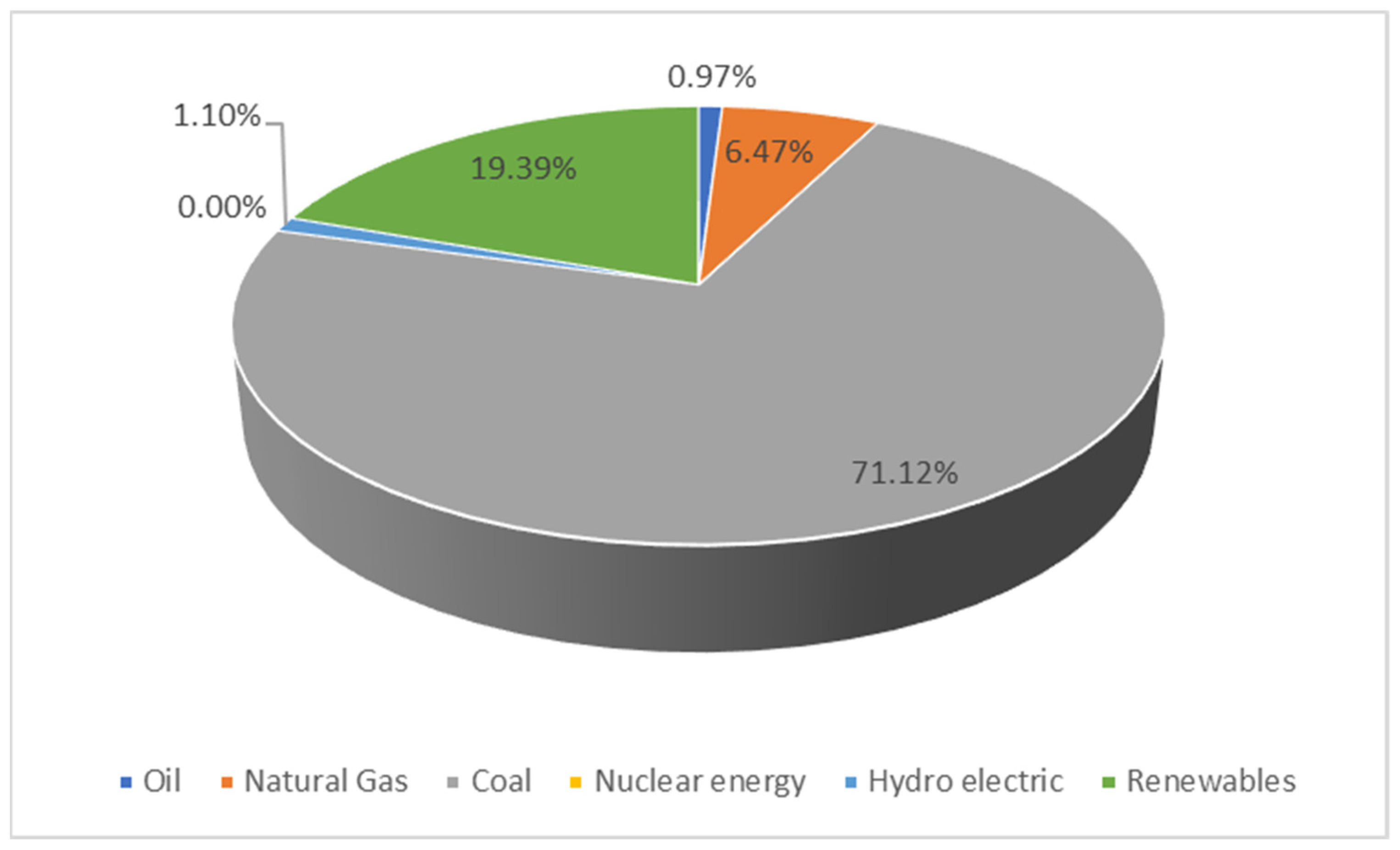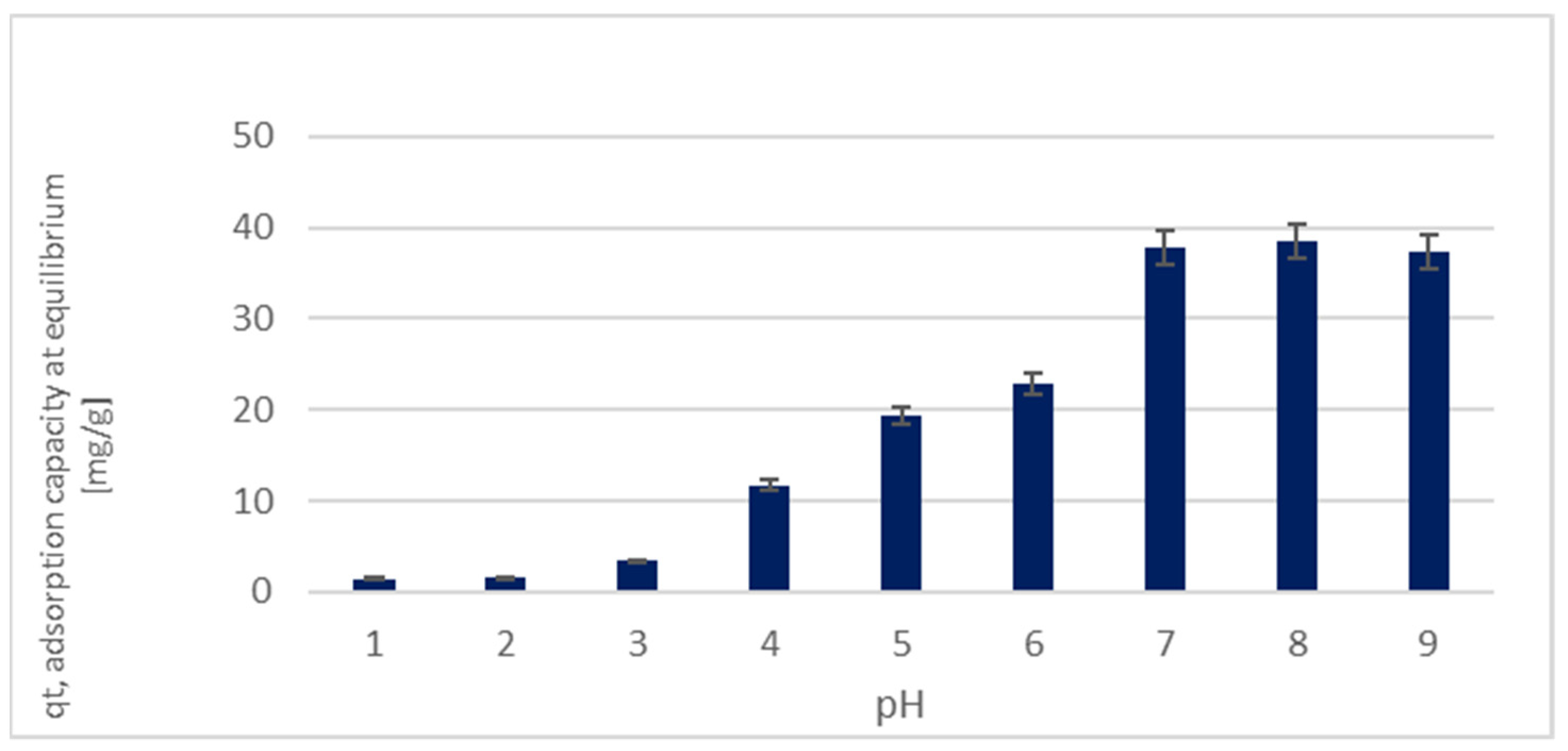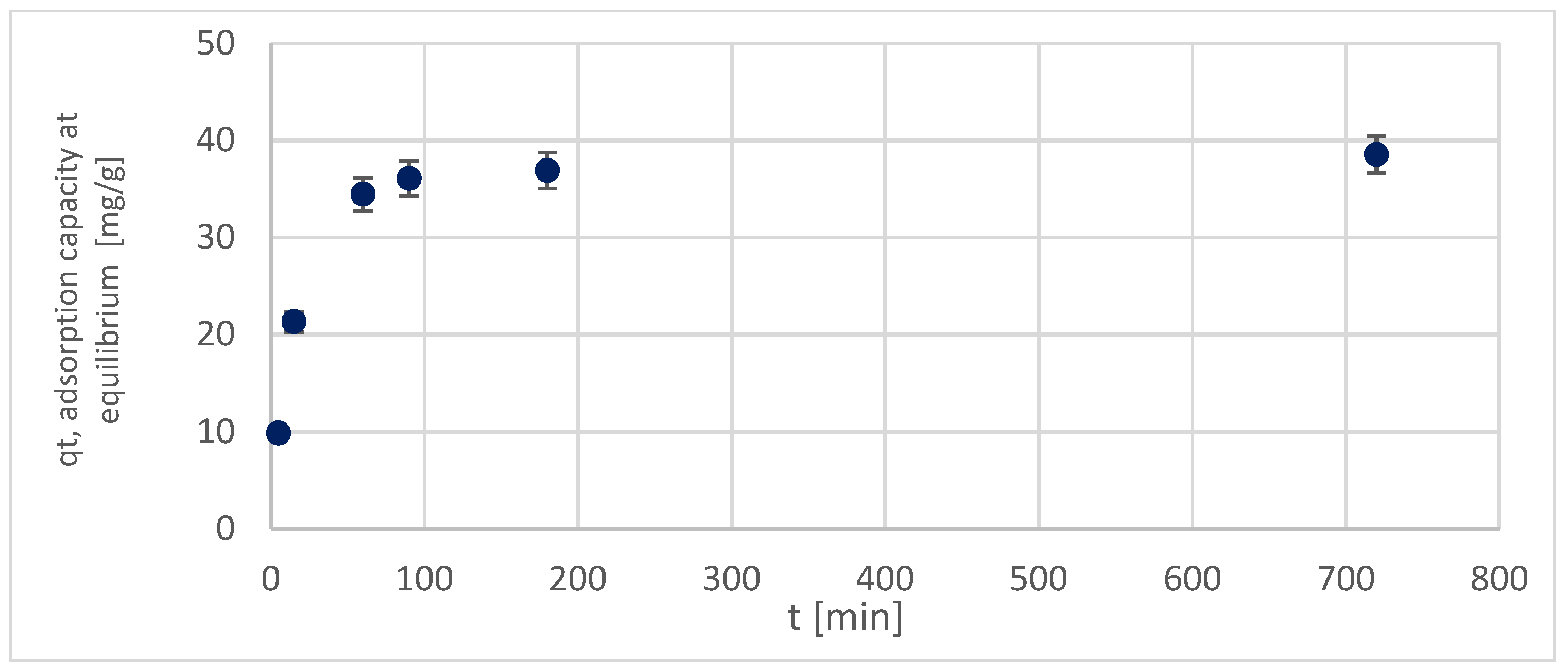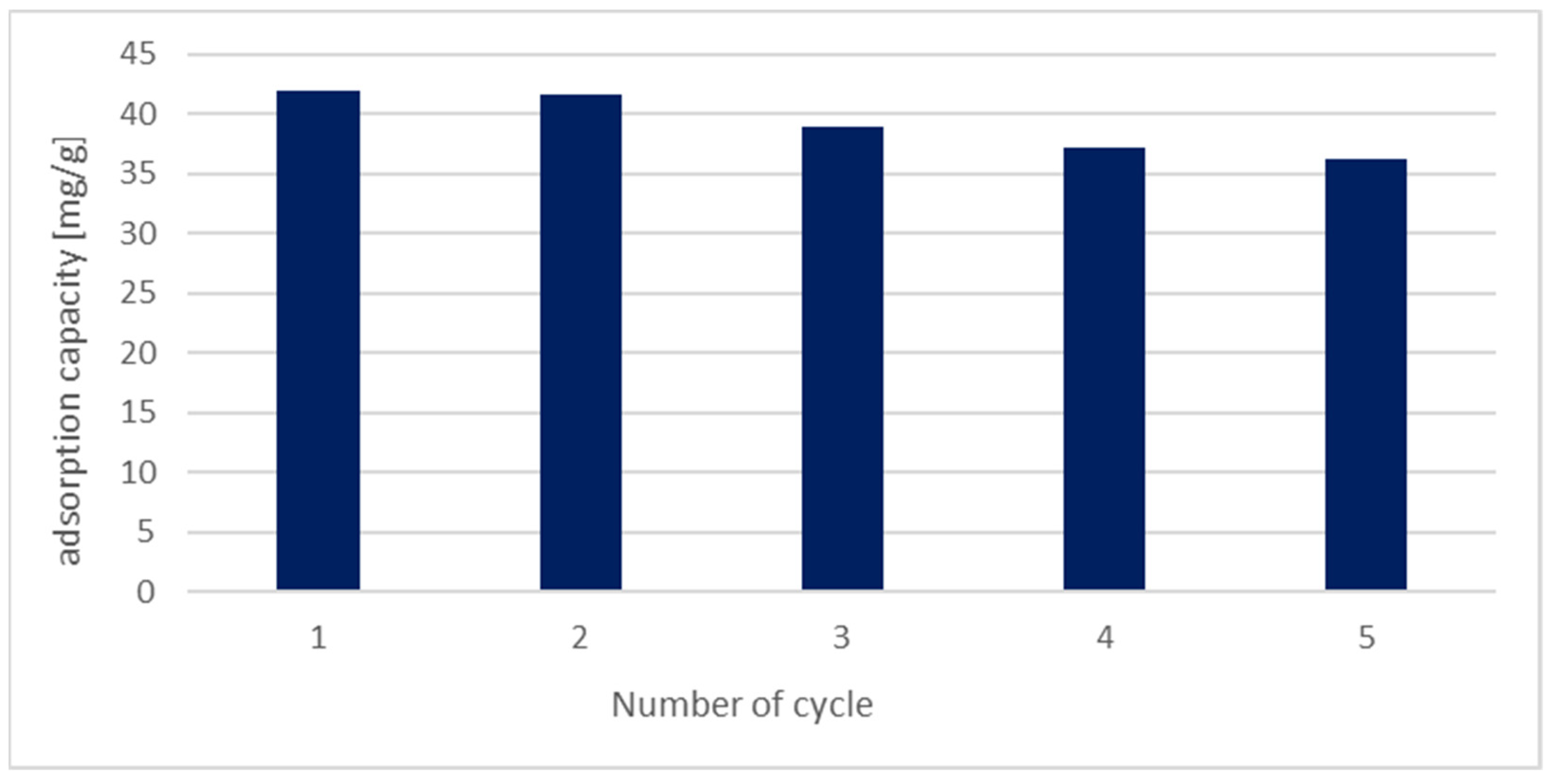The Role of Clean Coal Technologies in the Development of Renewable Energy Sources
Abstract
:1. Introduction
- Investments necessary to build the capacity to a level that could take over the role of coal.
- Access to the materials necessary to build this capacity.
- Storage of the obtained wind and solar energy and using it when needed.
- Ensuring stable and uninterrupted operation of the power grid.
1.1. Membrane Techniques
- -
- greenhouse gases, mainly CO2 from gases produced during the combustion of hard coal,
- -
- rare earth elements recovered from fly ash generated in the combustion of hard coal.
1.2. The Impact of CCT on the Development of Renewable Energy Sources
1.2.1. The Use of CO2 for Energy Production
1.2.2. Fly Ash as a Source of REEs
1.2.3. Stability of the Power System
2. Materials and Methods
3. Results and Discussion
- Materials necessary to produce membrane modules, including chitosan, reagents needed for its modification and praseodymium nitrate.
- Other operating costs, including labor costs, energy, depreciation, logistics, R&D, administration, taxes, external services, etc.
4. Conclusions
Author Contributions
Funding
Data Availability Statement
Conflicts of Interest
References
- European Commission. Renewable Energy Directive-Targets and Rules. Available online: https://energy.ec.europa.eu/topics/renewable-energy/renewable-energy-directive-targets-and-rules/renewable-energy-directive_en (accessed on 1 April 2024).
- Energy Institute. Statistical Review. Available online: https://www.energyinst.org/statistical-review (accessed on 11 May 2024).
- Eurostat. Eurostat Database. Available online: https://ec.europa.eu/eurostat/data/database (accessed on 1 April 2024).
- Wnukowski, D. Clean Coal Technologies: A Green Impulse for the Polish Energy Sector; Bulletin No. 32 (1144); Polish Institute of International Affairs: Warsaw, Poland, 2014.
- Chen, W.; Xu, R. Clean coal technology development in China. Energy Policy 2010, 38, 2123–2130. [Google Scholar] [CrossRef]
- Blaschke, W.; Nycz, N. Clean coal-preparation barriers in Poland. Appl. Energy 2003, 74, 343–348. [Google Scholar] [CrossRef]
- Brunetti, A.; Scura, F.; Barbieri, G.; Drioli, E. Membrane technologies for CO2 separation. J. Membr. Sci. 2010, 359, 115–125. [Google Scholar] [CrossRef]
- Ismail, A.F.; Goh, P.S.; Sanip, S.M.; Aziz, M. Transport and separation properties of carbon nanotube-mixed matrix membrane. Sep. Purif. Technol. 2009, 70, 12–26. [Google Scholar] [CrossRef]
- Zhao, Y.; Jung, B.T.; Ansaloni, L.; Ho, W.W. Multiwalled carbon nanotube mixed matrix membranes containing amines for high pressure CO2/H2 separation. J. Membr. Sci. 2014, 459, 233–243. [Google Scholar] [CrossRef]
- Rybak, A.; Rybak, A.; Sysel, P. Modeling of gas permeation through mixed-matrix membranes using novel computer application MOT. Appl. Sci. 2018, 8, 1166. [Google Scholar] [CrossRef]
- Liu, P.; Zhao, S.; Xie, N.; Yang, L.; Wang, Q.; Wen, Y.; Chen, H.; Tang, Y. Green Approach for Rare Earth Element (REE) Recovery from Coal Fly Ash. Environ. Sci. Technol. 2023, 57, 5414–5423. [Google Scholar] [CrossRef] [PubMed]
- Ragadhita, R.I.S.T.I.; Nandiyanto, A.B.D. Curcumin adsorption on zinc imidazole framework-8 particles: Isotherm adsorption using Langmuir, Freundlich, Temkin, and Dubinin-Radushkevich models. J. Eng. Sci. Technol. 2022, 17, 1078–1089. [Google Scholar]
- Ulfa, M.; Iswanti, Y. Ibuprofen adsorption study by Langmuir, Freundlich, Temkin and Dubinin-Radushkevich models using nano zinc oxide from mild hydrothermal condition. IOP Conf. Ser. Mater. Sci. Eng. 2020, 833, 012096. [Google Scholar] [CrossRef]
- Hu, Q.; Zhang, Z. Application of Dubinin–Radushkevich isotherm model at the solid/solution interface: A theoretical analysis. J. Mol. Liq. 2019, 277, 646–648. [Google Scholar] [CrossRef]
- Sutherland, C.; Venkobachar, C. A diffusion-chemisorption kinetic model for simulating biosorption using forest macro-fungus, fomes fasciatus. Int. Res. J. Plant Sci. 2010, 1, 107–117. [Google Scholar]
- Energy Dome. Available online: https://energydome.com (accessed on 2 May 2024).
- Zhong, C.; Xu, T.; Gherardi, F.; Yuan, Y. Comparison of CO2 and water as working fluids for an enhanced geothermal system in the Gonghe Basin, northwest China. Gondwana Res. 2023, 122, 199–214. [Google Scholar] [CrossRef]
- Liu, Y.; Hou, J.; Zhao, H.; Liu, X.; Xia, Z. A method to recover natural gas hydrates with geothermal energy conveyed by CO2. Energy 2018, 144, 265–278. [Google Scholar] [CrossRef]
- Castor, S.B.; Hedrick, J.B. Rare earth elements. Ind. Miner. Rocks 2006, 7, 769–792. [Google Scholar]
- Hardwerlibre.com. Available online: https://hardwerlibre.com (accessed on 2 May 2024).
- Fernandez, V. Rare-earth elements market: A historical and financial perspective. Resour. Policy 2017, 53, 26–45. [Google Scholar] [CrossRef]
- European Commission. COM/2023/160. Available online: https://eurlex.europa.eu/legalcontent/EN/TXT/?uri=CELEX%3A52023PC0160 (accessed on 1 May 2024).
- Rybak, A.; Rybak, A. Characteristics of some selected methods of rare earth elements recovery from coal fly ashes. Metals 2021, 11, 142. [Google Scholar] [CrossRef]
- Park, S.; Tracy, C.L.; Ewing, R.C. Reimagining US rare earth production: Domestic failures and the decline of US rare earth production dominance–Lessons learned and recommendations. Resour. Policy 2023, 85, 104022. [Google Scholar] [CrossRef]
- Theodosopoulos, V. The Geopolitics of Supply: Towards a new EU approach to the security of supply of critical raw materials. Policy 2020, 5, 1–10. [Google Scholar]
- Hurst, C.A. China’s ace in the hole: Earth rare elements. Jt. Force Q. 2010, 59, 121. [Google Scholar]
- Rybak, A. Poland’s Energy Mix and Energy Security of the Country. World Sci. News 2019, 128, 402–415. [Google Scholar]
- Depraiter, L.; Goutte, S. The role and challenges of rare earths in the energy transition. Resour. Policy 2023, 86, 104137. [Google Scholar] [CrossRef]
- Wdowin, M.; Franus, M. Analysis of fly ashes in terms of obtaining rare earth elements from them. Energy Policy 2014, 17, 369–380. [Google Scholar]
- Gompertz, B. On the nature of the function expressive of the law of human mortality, and on a new mode of determining the value of life contingencies. Philos. Trans. R. Soc. Lond. B Biol. Sci. 1825, 182, 513–585. [Google Scholar]
- Tjørve, K.M.C.; Tjørve, E. The use of Gompertz models in growth analyses, and new Gompertz-model approach: An addition to the Unified-Richards family. PLoS ONE 2017, 12, e0178691. [Google Scholar] [CrossRef] [PubMed]
- Cao, L.; Shi, P.-J.; Li, L.; Chen, G. A New Flexible Sigmoidal Growth Model. Symmetry 2019, 11, 204. [Google Scholar] [CrossRef]
- Liantoni, F.; Agusti, A. Forecasting bitcoin using double exponential smoothing method based on mean absolute percentage error. JOIV Int. J. Inform. Vis. 2020, 4, 91–95. [Google Scholar] [CrossRef]
- Saunders, L.J.; Russell, R.A.; Crabb, D.P. The coefficient of determination: What determines a useful R2 statistic? Investig. Ophthalmol. Vis. Sci. 2012, 53, 6830–6832. [Google Scholar] [CrossRef]
- Apache Commons Math. Available online: https://commons.apache.org/proper/commons-math/javadocs/api-3.6.1/org/apache/commons/math3/fitting/SimpleCurveFitter.html (accessed on 1 May 2024).
- Zhou, Z.H. Machine Learning; Springer Nature: Berlin/Heidelberg, Germany, 2021. [Google Scholar]
- de Wiljes, J.; Putzig, L.; Horenko, I. Discrete nonhomogeneous and nonstationary logistic and Markov regression models for spatiotemporal data with unresolved external influences. Commun. Appl. Math. Comput. Sci. 2014, 9, 1–46. [Google Scholar] [CrossRef]
- Liu, X. A Multi-Indexed Logistic Model for Time Series. Ph.D. Dissertation, East Tennessee State University, Johnson City, TN, USA, 2016. [Google Scholar]
- Carrara, S.; Alves Dias, P.; Plazzotta, B.; Pavel, C. Raw Materials Demand for Wind and Solar PV Technologies in the Transition Towards a Decarbonised Energy System; Publications Office of the European Union: Luxembourg, 2020; Volume 10, p. 160859. [Google Scholar]
- Grupa Azoty. Available online: https://raport2014.grupaazoty.com/2014/pl/finanse/podsumowanie/struktura-koszt%C3%B3w-rodzajowych/index.html (accessed on 8 June 2024).
- Manowska, A.; Bluszcz, A.; Chomiak-Orsa, I.; Wowra, R. Towards Energy Transformation: A Case Study of EU Countries. Energies 2024, 17, 1778. [Google Scholar] [CrossRef]








| REE Ion | Model | qe | K1 | K2 | a | b | Kp | xi | KDC | De | R2 |
|---|---|---|---|---|---|---|---|---|---|---|---|
| [mg/g] | [min−1] | [gmg−1min−1] | [mgg−1 min−1/2] | [mg/g] | [m2/min] | ||||||
| Pr | I pseudo-order | 13.206 | 0.012 | 0.473 | |||||||
| II pseudo-order | 44.248 | 0.004 | 0.995 | ||||||||
| Elovich | 6.014 | 5.561 | 0.856 | ||||||||
| Intraparticle | 1.302 | 14.908 | 0.610 | ||||||||
| Diffusion-chemisorption | 49.751 | 9.842 | 0.953 | ||||||||
| Boyd | 7.872 × 10−12 | 0.499 |
| REE Ion | Model | qm | KL | KF | 1/n | KDR | E | R2 |
|---|---|---|---|---|---|---|---|---|
| [mg/g] | [L/mg] | [mg/g] | [mol2 kJ−2] | [kJ/mol] | ||||
| Pr | Langmuir | 54.645 | 0.147 | 0.848 | ||||
| Freundlich | 12.334 | 0.310 | 0.672 | |||||
| Dubinin–Radushkevich | 39.411 | 3.349 × 10−5 | 122.188 | 0.958 |
| REE | Kd [mL/g] | k Pr/Nd | k Pr/Dy | k Pr/Gd | k Pr/Y | k Pr/Na | k Pr/Mg | k Pr/Ca | k Pr/Al | k Pr/Fe | k Pr/Si |
|---|---|---|---|---|---|---|---|---|---|---|---|
| Pr | 1824.529 | 29.84 | 35.34 | 37.60 | 42.84 | 1012.25 | 505.30 | 910.88 | 606.71 | 700.31 | 650.17 |
| Nd | 61.154 | ||||||||||
| Dy | 51.627 | ||||||||||
| Gd | 48.523 | ||||||||||
| Y | 42.592 | ||||||||||
| Na | 1.802 | ||||||||||
| Mg | 3.611 | ||||||||||
| Ca | 2.003 | ||||||||||
| Al | 3.007 | ||||||||||
| Fe | 2.605 | ||||||||||
| Si | 2.806 |
Disclaimer/Publisher’s Note: The statements, opinions and data contained in all publications are solely those of the individual author(s) and contributor(s) and not of MDPI and/or the editor(s). MDPI and/or the editor(s) disclaim responsibility for any injury to people or property resulting from any ideas, methods, instructions or products referred to in the content. |
© 2024 by the authors. Licensee MDPI, Basel, Switzerland. This article is an open access article distributed under the terms and conditions of the Creative Commons Attribution (CC BY) license (https://creativecommons.org/licenses/by/4.0/).
Share and Cite
Rybak, A.; Rybak, A.; Joostberens, J. The Role of Clean Coal Technologies in the Development of Renewable Energy Sources. Energies 2024, 17, 2892. https://doi.org/10.3390/en17122892
Rybak A, Rybak A, Joostberens J. The Role of Clean Coal Technologies in the Development of Renewable Energy Sources. Energies. 2024; 17(12):2892. https://doi.org/10.3390/en17122892
Chicago/Turabian StyleRybak, Aurelia, Aleksandra Rybak, and Jarosław Joostberens. 2024. "The Role of Clean Coal Technologies in the Development of Renewable Energy Sources" Energies 17, no. 12: 2892. https://doi.org/10.3390/en17122892
APA StyleRybak, A., Rybak, A., & Joostberens, J. (2024). The Role of Clean Coal Technologies in the Development of Renewable Energy Sources. Energies, 17(12), 2892. https://doi.org/10.3390/en17122892








